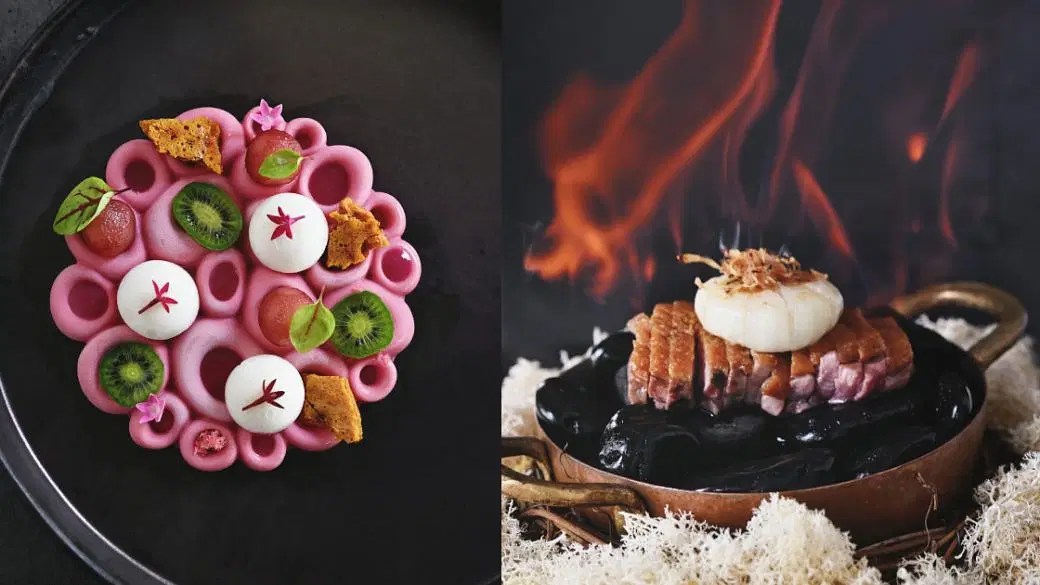Gourmet Travel Experiences A Culinary Journey
Gourmet Travel Experiences offer more than just a vacation; they provide an immersive culinary adventure. These experiences go beyond typical tourism, focusing on the exploration of local cuisines, unique dining opportunities, and cultural immersion through food. Whether it’s a hands-on cooking class in Tuscany, a wine tasting tour through Bordeaux, or a private chef dinner in a secluded villa, gourmet travel caters to discerning palates seeking authentic and memorable food-centric journeys.
This exploration delves into the diverse world of gourmet travel, examining popular and lesser-known destinations, unique experiences, cost considerations, and effective marketing strategies. We’ll uncover the factors that contribute to the overall value and appeal of these enriching travel packages, showcasing how they differ significantly from standard travel options. The aim is to provide a comprehensive understanding of this rapidly growing niche within the travel industry.
Defining Gourmet Travel Experiences
Gourmet travel experiences represent a significant departure from standard tourism, prioritizing culinary exploration and immersion in local food cultures as the central focus of the journey. These experiences go beyond simply eating; they aim to provide a holistic understanding of a region’s gastronomic heritage, its production methods, and the cultural significance of food within the community. This often involves interactions with local producers, chefs, and artisans, offering an intimate and enriching perspective unavailable through typical travel packages.Gourmet travel experiences are characterized by a deep dive into the culinary landscape of a chosen destination.
The destinations themselves are often selected for their rich culinary traditions, unique ingredients, or renowned culinary scenes. The overall experience is designed to be highly personalized and engaging, offering opportunities for hands-on participation and interaction with local experts. The quality of food and beverage is paramount, with a focus on fresh, seasonal, and locally sourced ingredients.
Types of Gourmet Travel Experiences
Several distinct types of gourmet travel experiences cater to diverse interests and preferences. These experiences offer a variety of ways to engage with food and drink on a deeper level.
- Culinary Tours: These guided tours typically involve visits to local markets, farms, wineries, and restaurants, providing insights into the region’s culinary traditions and production processes. Participants might sample regional specialties, learn about food preparation techniques, and interact with local producers.
- Cooking Classes: Hands-on cooking classes offer a unique opportunity to learn the art of preparing regional dishes under the guidance of experienced chefs. These classes often incorporate locally sourced ingredients and provide insights into regional culinary techniques and traditions.
- Wine Tasting Excursions: Wine regions worldwide offer specialized tours focusing on wine production, tasting, and vineyard visits. These excursions provide an opportunity to learn about viticulture, winemaking techniques, and the unique characteristics of different wines.
- Farm-to-Table Dining: This dining style emphasizes the use of fresh, locally sourced ingredients, often directly from the farm to the table. Farm-to-table restaurants often highlight seasonal menus and provide a connection to the origin of their food.
Gourmet Travel Experiences versus Standard Travel Packages
The key difference between gourmet travel experiences and standard travel packages lies in the prioritization of culinary exploration. Standard travel packages may include meals, but these are often generic and don’t necessarily reflect the local culinary scene. Gourmet travel experiences, conversely, place food and drink at the heart of the itinerary, offering opportunities for immersive and educational experiences.
Gourmet travel experiences often involve indulging in unique culinary adventures. After a day exploring local markets and restaurants, the perfect end to your trip might involve settling into your luxurious accommodation and enjoying a film on a state-of-the-art Automated Home Theater , reliving the day’s gastronomic highlights in comfort. This seamless blend of high-end travel and home entertainment elevates the entire experience, leaving you with lasting memories of both culinary and cinematic excellence.
This difference is reflected in the price point, with gourmet travel experiences typically commanding a higher cost due to the specialized nature of the activities and the focus on high-quality ingredients and experiences. Furthermore, the level of personalization and engagement is considerably higher in gourmet travel, fostering deeper connections with the local culture and community.
Gourmet travel experiences often involve immersing oneself in unique culinary cultures. The meticulous planning and execution required for such trips mirror the precision needed in other fields, such as Interior Design Project Management , where attention to detail and skillful coordination are paramount. Ultimately, both successful gourmet adventures and successful design projects hinge on thoughtful organization and a keen eye for aesthetics.
Destinations for Gourmet Travel

Source: com.sg
Gourmet travel transcends simple tourism; it’s an immersive experience centered around exploring diverse culinary landscapes. These journeys delve into the heart of a region’s culture, history, and traditions, all expressed through its unique food and drink offerings. From Michelin-starred restaurants to hidden street food stalls, the possibilities are vast and exciting. This section highlights some of the world’s top gourmet destinations, categorized for easier planning and exploration.
Top Global Gourmet Destinations
The following table presents a selection of globally renowned destinations known for their exceptional culinary scenes. The choices represent a diverse range of cuisines and price points, allowing for a tailored gourmet travel experience.
| Destination | Cuisine Focus | Notable Experiences | Price Range |
|---|---|---|---|
| Kyoto, Japan | Kaiseki, traditional Japanese cuisine | Multi-course Kaiseki dinners, tea ceremonies, visits to local markets | High |
| Lyon, France | French, particularly Lyonnaise cuisine | Michelin-starred restaurants, bouchons (traditional Lyonnaise bistros), wine tasting in Beaujolais | Mid-High |
| Bologna, Italy | Italian, specifically Emilia-Romagna cuisine | Pasta-making classes, visits to Parmigiano-Reggiano and balsamic vinegar producers, truffle hunting | Mid |
| Bangkok, Thailand | Thai cuisine, street food | Exploring diverse street food markets, cooking classes, fine dining experiences | Low-Mid |
| San Sebastián, Spain | Basque cuisine, pintxos | Pintxos hopping (bar-hopping for small snacks), Michelin-starred restaurants, cooking classes | Mid-High |
Kyoto’s Kaiseki cuisine, for example, is a highly refined multi-course meal showcasing seasonal ingredients and meticulous presentation. Lyon’s culinary heritage is deeply rooted in its history as a gastronomic center, with bouchons offering classic Lyonnaise dishes like quenelles and salade lyonnaise. Bologna, the heart of Emilia-Romagna, boasts rich culinary traditions centered around pasta, cured meats, and cheeses. Bangkok offers a vibrant street food scene alongside sophisticated fine dining establishments.
Gourmet travel experiences often involve seeking out unique culinary adventures. Elevating this pursuit to the next level, consider chartering a luxury yacht, perhaps through a service like Luxury Yacht Rentals , allowing for private, bespoke dining experiences in stunning locations. This way, your gourmet journey becomes seamlessly integrated with the breathtaking scenery and unparalleled comfort, enhancing every aspect of the culinary experience.
Finally, San Sebastián’s pintxos culture offers a unique and social dining experience.
Lesser-Known Gourmet Destinations
Beyond the well-trodden paths lie hidden culinary gems offering unique and unforgettable experiences. These destinations provide a chance to discover authentic flavors and cultural nuances often overlooked by mass tourism.Exploring these lesser-known destinations offers a more intimate and authentic gourmet experience. The emphasis shifts from renowned Michelin stars to the heart of local culinary traditions.
- Chiang Mai, Thailand: While Bangkok is famous, Chiang Mai offers a more tranquil culinary experience, focusing on Northern Thai cuisine and its unique ingredients and cooking techniques. Expect flavorful curries, unique salads, and delicious street food.
- San Miguel de Allende, Mexico: This charming colonial city boasts a vibrant culinary scene blending traditional Mexican flavors with international influences. The emphasis is on fresh, local ingredients and a relaxed atmosphere.
- Matera, Italy: Known for its ancient cave dwellings, Matera also offers a unique culinary experience focusing on local, rustic dishes and regional specialties.
- Hoi An, Vietnam: This ancient trading port town boasts a rich culinary heritage, with a blend of Vietnamese, Chinese, and Japanese influences. The street food scene is particularly vibrant and diverse.
Experiences Within Gourmet Travel
Gourmet travel transcends simple sightseeing; it’s an immersive journey that tantalizes the taste buds and cultivates a deeper understanding of a region’s culinary heritage. It’s about experiencing food not just as sustenance, but as a cultural artifact, a reflection of history, environment, and community. This section delves into the diverse experiences that define gourmet travel, highlighting their unique contributions to a truly memorable trip.Gourmet travel offers a plethora of unique and enriching experiences, moving beyond the typical restaurant meal to encompass a deeper engagement with the food and its origins.
These experiences often focus on the human element of food production, creating lasting memories and fostering a greater appreciation for the culinary arts.
Diverse Gourmet Travel Experiences
The spectrum of gourmet travel experiences is vast and varied, catering to diverse interests and preferences. These curated experiences often prioritize personalized attention and exclusive access to culinary treasures.
- Private Chef Dinners: Imagine a meticulously crafted meal prepared by a renowned chef in the privacy of a luxurious villa or a charming countryside setting. These intimate dinners offer a personalized culinary journey, tailored to individual tastes and preferences, with opportunities to interact directly with the chef and learn about their culinary philosophy.
- Foraging Expeditions: Embark on an adventurous journey into the wild, guided by an expert forager who reveals the hidden treasures of the local ecosystem. Discover edible plants, mushrooms, and herbs, learning about their unique properties and culinary applications. This hands-on experience connects you directly with the land and its bounty.
- Visits to Artisanal Food Producers: Meet the passionate artisans behind the region’s most prized culinary creations. Tour a family-run olive oil mill, a traditional cheese factory, or a small-batch chocolate maker. Engage in conversation, learn about their techniques, and sample their exquisite products. These visits offer an unparalleled insight into the dedication and craftsmanship that goes into creating exceptional food.
Sustainability and Ethical Sourcing in Gourmet Travel
Sustainability and ethical sourcing are increasingly vital considerations in gourmet travel. Responsible tourism ensures that the culinary experiences not only delight the palate but also contribute positively to the environment and local communities. This involves choosing experiences that prioritize locally sourced ingredients, support fair trade practices, and minimize environmental impact. For example, selecting a tour operator committed to carbon offsetting or choosing accommodations that utilize sustainable practices demonstrates a commitment to responsible travel.
Furthermore, engaging with local producers directly supports their livelihoods and preserves traditional culinary practices.
A Hypothetical 7-Day Gourmet Travel Itinerary: Tuscany, Italy
This itinerary focuses on a 7-day gourmet journey through Tuscany, highlighting its rich culinary heritage and stunning landscapes.
| Day | Activity | Culinary Highlights |
|---|---|---|
| 1 | Arrival in Florence, check into a charming boutique hotel. Afternoon walking tour of the Oltrarno district, focusing on artisan workshops. | Aperitivo with local Tuscan wines and cheeses at a traditional trattoria. |
| 2 | Cooking class focusing on regional Tuscan cuisine. | Hands-on preparation and enjoyment of a multi-course Tuscan meal, including handmade pasta and regional specialties. |
| 3 | Day trip to the Chianti region, visiting vineyards and olive oil mills. | Wine tasting at a family-run vineyard, olive oil tasting and tour of a traditional mill. Lunch at a rustic farmhouse restaurant. |
| 4 | Truffle hunting experience in the Tuscan countryside. | Lunch featuring freshly foraged truffles, paired with local wines. |
| 5 | Visit to a traditional balsamic vinegar producer in Modena. | Tasting of various balsamic vinegars and learning about the production process. Dinner at a Michelin-starred restaurant in Modena. |
| 6 | Market visit in Florence, followed by a private chef dinner. | Exploring the vibrant Mercato Centrale, followed by a personalized dinner featuring seasonal ingredients sourced from the market. |
| 7 | Departure from Florence. | Final breakfast featuring regional pastries and coffee. |
The Cost and Value of Gourmet Travel
Gourmet travel, while undeniably luxurious, presents a unique blend of cost and value. The price tag can be significant, varying wildly depending on several key factors, but the experiences and memories created often justify the expense for discerning travelers. Understanding the cost drivers and appreciating the intangible benefits are crucial to making an informed decision.The cost of a gourmet travel experience is influenced by a complex interplay of factors.
Accommodation choices significantly impact the overall budget. Staying in a five-star hotel with Michelin-starred dining options will naturally be far more expensive than a charming boutique hotel or a well-appointed Airbnb. Transportation costs also vary considerably, from budget-friendly flights and local buses to private jets and chauffeured vehicles. The selection of activities further contributes to the final price.
Gourmet travel experiences often involve seeking out unique culinary adventures. Imagine meticulously planning your itinerary, ensuring every detail is perfect, from restaurant reservations to private chef experiences. This level of organization is easily mirrored in your home life with the help of advanced Home Automation Systems , allowing you to control lighting, temperature, and even music to create the ideal atmosphere upon your return from these exquisite journeys.
Returning to a perfectly controlled home enhances the overall luxury of these gourmet travel experiences.
Private wine tastings, exclusive cooking classes, and guided tours of artisanal food producers command higher fees than more accessible options.
Factors Influencing the Cost of Gourmet Travel Experiences
Accommodation, transportation, and activity costs are the primary drivers of gourmet travel expenses. Luxury hotels in prime locations, private transportation like chartered yachts or private cars, and exclusive experiences such as private chef dinners or hot air balloon rides over vineyards all contribute to a higher price point. Conversely, opting for more modestly priced accommodations, utilizing public transport where feasible, and selecting less exclusive activities can significantly reduce the overall cost.
For example, a week-long gourmet trip to Tuscany could cost anywhere from $3,000 (budget-friendly option with shared transportation and simpler accommodation) to $30,000 (luxury option with private villas, Michelin-starred meals, and private tours).
The Value Proposition of Gourmet Travel
Gourmet travel offers a value proposition that extends far beyond the mere consumption of fine food and wine. It’s an investment in creating lasting memories and enriching life experiences. The immersion in local cultures, the connection with passionate artisans and chefs, and the exploration of unique landscapes all contribute to a transformative travel experience. Unlike mass-market tourism, gourmet travel fosters deeper engagement with a destination, leading to a richer understanding and appreciation of its culinary heritage and cultural nuances.
The intangible benefits – the stories, the connections, and the memories – are often the most valuable aspects of the journey.
Budget Levels for Gourmet Travel
Gourmet travel caters to a wide range of budgets. A budget-conscious traveler might opt for a weekend getaway to a nearby region known for its culinary scene, focusing on exploring local markets, enjoying meals at moderately priced restaurants, and participating in free or low-cost walking tours. This could cost around $500-$1,500. A mid-range option might involve a week-long trip to a popular culinary destination, staying in comfortable hotels, enjoying a mix of fine dining and local eateries, and participating in a few curated food experiences.
This could range from $2,000-$5,000. High-end gourmet travel, on the other hand, involves luxurious accommodations, exclusive experiences, and private transportation, potentially costing $10,000 or more per person for a week-long trip. For example, a luxury culinary tour of Japan could easily exceed $20,000, including stays in traditional Ryokans, private sushi-making classes, and visits to renowned sake breweries.
Marketing and Promotion of Gourmet Travel: Gourmet Travel Experiences
Marketing gourmet travel experiences requires a sophisticated approach that highlights the unique blend of culinary exploration, cultural immersion, and luxurious comfort. Successful campaigns resonate with the target audience’s desire for exceptional experiences and emphasize the value proposition beyond simply a vacation. This involves crafting compelling narratives, utilizing visually stunning imagery, and leveraging the power of authentic storytelling.
Sample Marketing Materials for a Gourmet Travel Package
This Tuscan Culinary Escape package, aimed at affluent couples aged 40-60 seeking a romantic and enriching experience, offers a curated journey through the heart of Tuscany. The package includes private cooking classes with Michelin-starred chefs, exclusive wine tastings at prestigious vineyards, and stays in luxurious, historic villas. The unique selling proposition is the personalized itinerary, designed to cater to individual preferences, ensuring an unforgettable, bespoke experience.
The marketing materials will emphasize the romance, the authenticity of the Tuscan culinary heritage, and the exclusivity of the experience, utilizing evocative language and high-quality imagery. A sample tagline could be: “Savor the Taste of Tuscany: A Culinary Journey for the Discerning Palate.” A shorter, punchier tagline for social media could be: “Tuscan Romance: Food, Wine, and Unforgettable Memories.”
Visual Appeal of Gourmet Travel Experiences
High-quality visuals are crucial in showcasing the allure of gourmet travel. Images should evoke a sense of luxury, adventure, and culinary delight. For example, a vibrant image depicting a bustling marketplace overflowing with exotic fruits and spices, the aroma filling the air, would perfectly capture the sensory richness of a destination. Another image could showcase a meticulously plated dish, highlighting the artistry and precision of gourmet cuisine, alongside a close-up of a satisfied diner’s expression.
A panoramic shot of a sun-drenched vineyard stretching across rolling hills, with a glass of wine in the foreground, would effectively convey the idyllic setting of a wine tasting experience. Images of smiling faces, engaged in culinary activities or enjoying convivial moments with locals, would underscore the human connection at the heart of these experiences.
Storytelling and Personal Experiences in Promoting Gourmet Travel
Authentic storytelling is vital in connecting with potential travelers on an emotional level. Instead of merely listing features, marketing materials should weave narratives that evoke a sense of place, culture, and the transformative power of gourmet travel. Sharing personal anecdotes from past travelers, focusing on their memorable experiences and emotional connections, can build trust and credibility. Testimonials from satisfied clients, highlighting their culinary discoveries and cultural encounters, can powerfully reinforce the value proposition.
Gourmet travel experiences often involve luxurious accommodations, and a key element of luxury is control over your environment. For instance, imagine waking up in a stunning villa with the perfect light, thanks to the seamless integration of Automated Blinds which adjust automatically to your preferences. This level of sophisticated comfort elevates the entire gourmet travel experience, allowing you to fully savor every moment and relish the exquisite culinary delights awaiting you.
Blog posts and articles featuring immersive narratives, describing the sights, sounds, tastes, and smells of specific destinations, can effectively transport potential travelers to the heart of the experience, fostering a desire to embark on their own culinary adventure. Using influencer marketing, with food bloggers and travel enthusiasts sharing their genuine experiences, can also effectively reach the target audience.
Last Recap
Ultimately, gourmet travel experiences transcend the typical tourist experience, offering a deeper connection to culture and a profound appreciation for culinary artistry. By carefully considering destinations, choosing authentic experiences, and understanding the cost-benefit analysis, travelers can craft unforgettable journeys that tantalize the taste buds and enrich the soul. The memories created through these curated culinary adventures will linger long after the trip concludes, leaving a lasting impression on both the palate and the spirit.
FAQ Guide
What is the best time of year to embark on a gourmet travel experience?
The ideal time depends heavily on the destination. Research the local climate and harvest seasons to find the best time for optimal ingredient availability and pleasant weather.
Are gourmet travel experiences suitable for solo travelers?
Absolutely! Many gourmet travel experiences cater to solo travelers, offering opportunities to meet like-minded individuals and enjoy unique culinary adventures independently.
How can I ensure the sustainability of my gourmet travel choices?
Look for tour operators and establishments committed to ethical sourcing, local partnerships, and minimizing environmental impact. Consider choosing experiences that support local communities and prioritize sustainable practices.
What if I have dietary restrictions or allergies?
Always inform your tour operator or chosen establishment about any dietary needs or allergies in advance. Reputable providers will accommodate these requests to ensure a safe and enjoyable experience.









